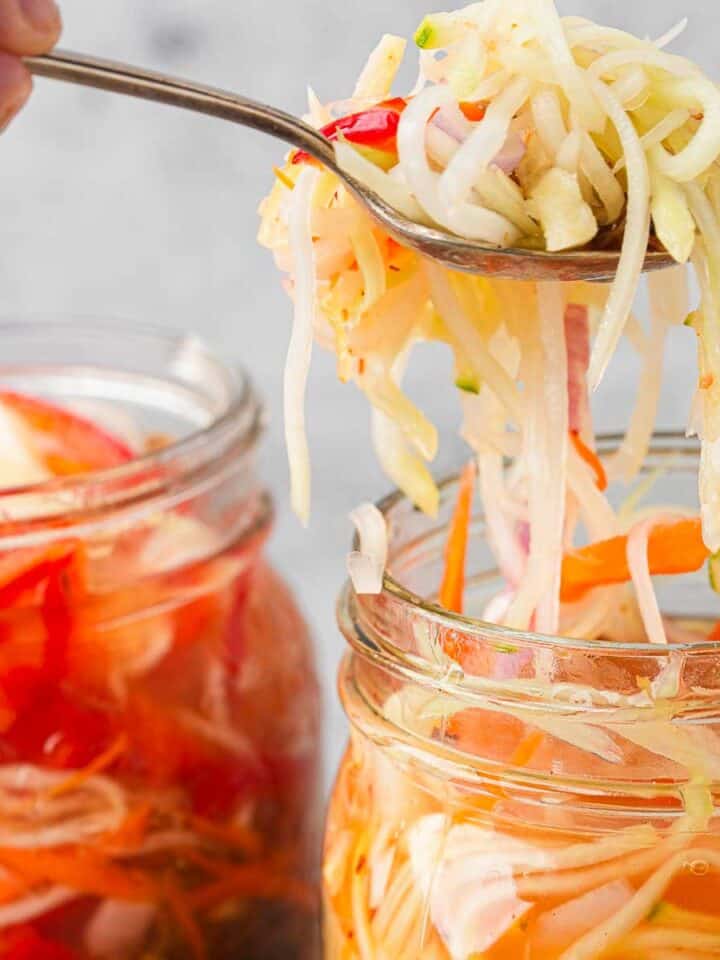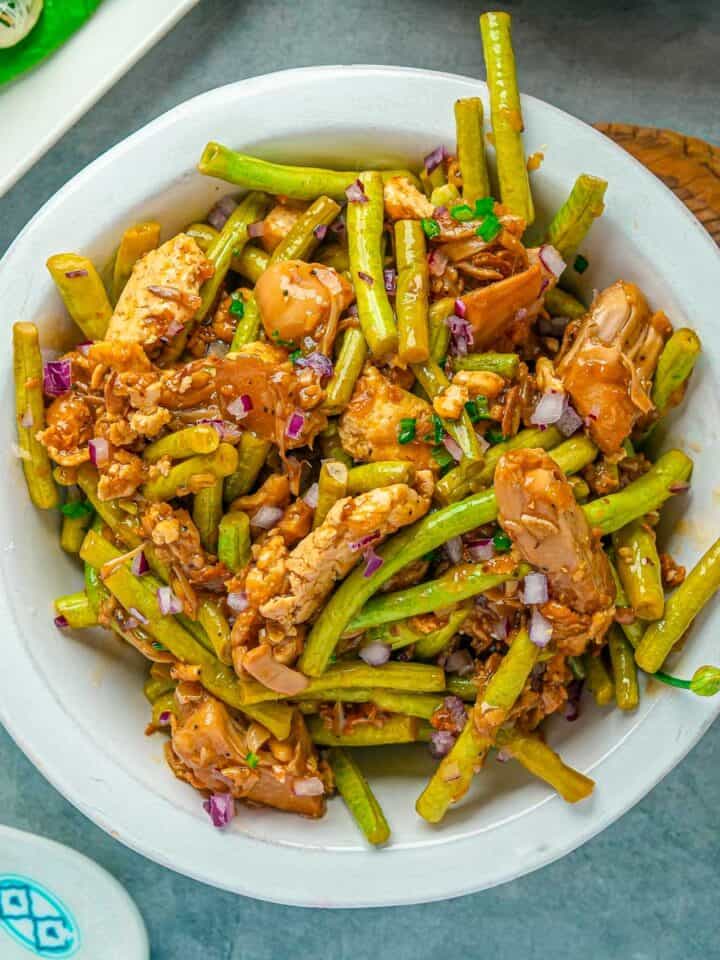*This post may contain affiliate links. Read more »
Spicy, lemongrass scented taro leaves simmered in coconut milk are what Laing is all about. This is a classic Filipino veggie side, that is seriously nourishing!


Enter your email & I'll send it to your inbox. Plus, get great new recipes from me every week!
By submitting this form, you consent to receive emails from Cinnamon Snail.
Back in 2016 when I spent time cooking at the World Street Food Congress in Manila, everyone told me that this was the one plant-based dish I HAD to try. I mean, I had eatten ensaladang talong, and LOVED sitaw and kalabasa, so I was ready for some dark leafy greens too. However, laing is often made with at least belacan (shrimp paste), if not pieces of pork, making it off limits for my vegan ass.
So after a lot of research and tweaking, studying traditional Bicolano methods of preparing it, I came up with this recipe, which has the perfect texture and flavor, without any cholesterol or harm caused to animals.
Jump to:
🤷♀️ What is Laing?
Laing, (pronounced in two sylables like lah-ing) means withered or dried leaves in Tagalog, which makes pretty good sense since it is made from dried taro leaves.
Simmered in coconut milk with aromatics, Laing, also known as "Pinangat," originated in the Bicol region of the Philippines. People make it a lot of different ways, texture-wise, but generally it has a creamy texture. Garlic and bird’s eye chilies are usually part of the deal, and folks who like it more aromatic (that’s me!) use lemongrass and ginger in their laing recipes too.
The trick to great laing is not overcooking it. When cooked too long and too high, the coconut milk makes the leaves oily, and the taro gets mushy too.
The careful instructions I have laid out in this recipe are going to help you to make absolutely perfect laing in under 20 minutes that everyone who eats with you can, and certainly WILL mess with. Let's get cooking!


🤫 Learn the secrets for perfect vegan Filipino meals
This guide to my most popular plant-based recipes from the Philippines is 100% FREE, & you'll love the actual heck out of it 🥰
🥰Why you'll love this vegan recipe
🥥 Taro Coconut Magic: Taro leaves are super nutritious, containing lots of fiber and are very low in calories. They contain TONS of folate, vitamin A, vitamin C, and plenty of essential minerals. The use of full-fat coconut milk lends a luxurious creaminess to the dish while balancing the flavors of the taro leaves and aromatics.
✊Vegan AF & GF: Like all of my vegan Filipino recipes, this laing is made without fish paste, pork belly or any animal products at all! It also happens to be one of the only gluten-free vegan recipes on my blog made with taro leaves.
🕒 Quick and Easy: This recipe comes together in under 20 minutes, using only one pan, making it perfect for busy weeknights when you don’t want to take forever to get dinner made or make a gosh darned mess of your whole kitchen.
✅ Tested and Approved Worldwide: Like all of the vegan recipes I share, after meticulous testing and refining, this laing recipe has been validated by a massive group of hundreds of recipe testers globally. That includes back in the Philippines, where Lain comes from, ensuring consistent success in kitchens everywhere.
🌶️ Ingredients & Subsitutions

Dried Taro Leaves (Dahon ng Gabi)
The heart of the dish, taro leaves, which you can find at almost any Asian grocery store, or online, soften and absorb flavors while imparting a unique earthy taste. They are packed to the gills with dietary fiber, vitamins, and minerals.
If you can’t find them, you can substitute with bunched spinach, malabar spinach (a.k.a. chang choy), curly kale leaves, or collard greens. Just be sure to remove the stems before roughly chopping the fresh greens, and don’t cook them quite as long.
Lemongrass (Tanglad)
Not everyone uses lemongrass in their laing, but hear me out. The acids in the oils from lemongrass not only balance the flavors in this recipe, they also help to slightly curdle and thicken the coconut milk as it cooks, making the final dish richer. Fresh lemongrass is easily found at just about all Asian markets.
For this beloved Filipino dish, much like I do for making sambal goreng potatoes, or Indonesian tempeh, I only recommend using the inner core of lemongrass stalks, bashed to release their citrusy oils.
If you can’t get fresh lemongrass, you can replace it in this recipe with a spoonful of dried lemongrass powder, which I recommend keeping in your pantry anyway for making dishes like bakwan sayur, tempeh mendoan, lemongrass roasted tofu banh mi, or the classic Filipino dessert, turon.
Thai Chili / Bird’s Eye Chili (Siling Labuyo)
Oh God, Please help me. I am hopelessly addicted to these small red chilies that bring flavorful heat to this taro leaf recipe. My blog sports them in a kinda embarrassing number of dishes, from hot sauces like my sambal oelek recipe and sriracha recipe, to Indonesian dishes like bihun goreng and tahu goreng. I am seriously never without them in my fridge.
Can’t get red bird’s eye chilies where you live? This recipe is great made with Indian green chili peppers (same as you would use to make hari mirch ka achar), or skip the chilies completely if you don’t love spice, and the recipe still works great.
Vegetarian Oyster Sauce
Again, not everyone uses vegan oyster sauce in their recipe, but since my recipe forgoes the dried fish, I turn to it to help provide umami and a little sweetness in my recipe. Made from mushrooms, it somewhat mimics the flavor of traditional oyster sauce, at least well enough for me to use it in mie goreng and vegan tom yum fried rice.
Can’t find veg. oyster sauce? You can substitute with vegan fish sauce, kecap manis, or tamari for a gluten-free option, or hoisin sauce for a similar sweet, umami punch.
Coconut Milk (Gata)
Coconut milk is such an essential part of Flipino cooking! You see it used in everything from desserts like buko pandan and suman, to curries like kalabasa. My preference in the US is to use canned full-fat coconut milk to form the creamy base of laing.
If you want less fat, you can substitute with lite coconut milk, or even use unsweetened almond milk, oat milk or soy milk in its place. Want more richness? Coconut cream can be a great option. I am talking about the stuff you would use to make kem chuoi, -not "cream of coconut" used for making trash-quality piña coladas at an airport bar, ok?
*See the recipe card at the bottom of the page for exact quantities, nutritional info, and detailed cooking directions.
🤯Variations
Spicy Bicol
Inspired by the meatiness and heat adored by folks in the province of Bicol, this variation adds fried tofu cubes or seitan strips (made from my vegan chicken recipe) along with the taro leaves in coconut milk. It also packs more bird’s eye chilies for extra heat and a squeeze of calamansi or lime juice for a tangy twist.
With Mushrooms:
Mix in a variety of mushrooms, such as oyster mushrooms (which make insanely good vegan shawarma) or lion's mane (which make the most steak-like vegan fajitas in the galaxy). Add the mushrooms at the same time you are sautéing the onions so they get a nice texture and slight browning to them before the coconut milk and whatnot are added. This way, the mushrooms add a meaty texture and upgrade the umami flavor of the dish.
📖 How to make this easy laing recipe
Nail this Filipino taro leaf recipe on your first shot by following these step-by-step photos with helpful tips. Or scroll down to the bottom of this page for the easy-to-print recipe card.

Step One
Sweat the Onions:
In a large skillet over medium heat, warm up the canola oil. After 90 seconds when the oil is hot, add the diced onion and sauté for a few minutes until translucent, stirring occasionally.

Step Two
Broom, Broom. Garli’ Davidson:
Stir in the minced cloves of garlic and grated ginger to the skillet. Sauté for a minute or so, just until fragrant.

Step Three
Lemongrass Assault and Battery:
Using a heavy knife or cleaver, gently bash the lemongrass stalks to release their oils.

Step Four
Umami Thurman:
Add the bruised lemongrass stalks to the skillet along with the sliced bird’s eye chilies. Pour in the rice vinegar, vegetarian oyster sauce and sprinkle in the salt.
Stir-fry everything together, letting the flavors intensify as the oyster sauce caramelizes just a wee little bit.

Step Five
Coconut Milk Bath:
Pour the coconut milk into the skillet, stirring gently to combine with the aromatics. Bring the mixture to a gentle simmer.

Step Six
Taro Leaf Spa Time:
Stir in the gabi leaves (dried taro leaves), ensuring they are submerged in the coconut milk mixture. Cover the skillet and lower the heat to a simmer. Let the leaves steam for 8-10 minutes, just until the leaves are tender.

Step Seven
Garnish and Serve with Fiery Finesse:
Transfer the laing to a pretty serving dish. Garnish with additional bird’s eye chilies, fresh cilantro leaves, and minced red onion or fried shallots for added color and flavor. Serve hot and enjoy the spicy, creamy goodness!
💡Serving Ideas
For a hearty, healthy Filipino meal, serve the this authentic bicolano laing over white rice alongside dishes like tofu sisig, coconut milk simmered langka (jackfruit), or ginasang munggo. Since these are cooked, I like to freshen up the meal by serving achara, a classic Filipino green papaya slaw, on the side.
These greens also are great over steamed rice. I love em over nasi kunyit, nasi minyak, and nasi uduk. But they are great on more complex rice recipes too like khao pad or vegan kimchi fried rice.
Of course, you deserve a great Filipino dessert since you are eating your greens, right? Make ube glazed karioka, tupig, sago't gulaman, or something non-Pinoy like Vietnamese banh flan for dessert, why dontcha?
👉Top tips
- Don’t Mess with Trash Quality Taro Leaves: Make sure the taro leaves aren’t dusty, disintegrating, and brittle, which are signs that they are super old. Similarly, if dark and overly pliable, they could have been exposed to moisture and might not be safe to eat.
- Adjust Heat Carefully: Bird’s eye chilies can vary in spice level. Taste and adjust the amount according to your preference for heat. Remember, you can always add more heat later, but it’s basically impossible to reduce it once it’s already too spicy for ya’.
- Simmer Slow and Low: Allow the coconut milk to simmer gently over low heat once the taro leaves are added. This slow cooking process helps the leaves absorb the flavors while preventing the coconut milk from curdling.
🤷♀️ FAQs
Fresh taro leaves can be used if available (they almost never are here in the USA). Blanch them briefly before adding to the dish to ensure they cook similarly, and don’t taste astringent.
The spiciness of vegan laing can vary depending on the amount of bird’s eye chilies used. I wrote this recipe to be a spicy dish, but not one with incendiary, intolerable heat, or anything like that. Start with a small amount and adjust to your own personal heat preference.
If vegan laing is too thick, add a splash of coconut milk, a dash of water, some unsalted vegetable broth. If it’s too thin, simmer uncovered for a few more minutes to thicken the sauce.
🥶Refrigeration: Store leftover vegan laing in an airtight container in the refrigerator for up to three days. Make sure the container is sealed tightly to preserve freshness.
❄️Freezing: To freeze this classic laing recipe, transfer it to a freezer-safe container or reusable bag. Seal tightly and freeze for up to three months. Thaw overnight in the refrigerator before reheating.
🌡️Thawing: For best results, thaw frozen vegan laing overnight in the refrigerator before reheating. Thawing at room temperatures for hours isn’t a great plan, as far as food safety is concerned.
🔥 Stovetop Reheating:
Transfer the thawed vegan laing to a saucepan.
Heat over low to medium heat, stirring occasionally, until heated through.
Add a splash of coconut milk or vegetable broth if needed to adjust consistency.
Add fresh garnishes when serving.
⚡️ Microwave Reheating:
Place the thawed vegan laing in a microwave-safe dish.
Cover loosely with a microwave-safe lid or plate to prevent splatters.
Microwave on medium heat in 1-minute intervals, stirring in between, until heated through.
🤏 Add fresh garnishes when serving, to freshen the dish right back up!
✌️My faves to serve with this:

Laing Recipe (Filipino Taro leaves in Coconut Milk)
Equipment
- Cleaver
Ingredients
- 2 tablespoons canola oil vegetable oil, or sunflower oil
- ½ cup onion diced
- 4 teaspoons garlic minced
- 1 teaspoon fresh ginger grated or minced
- 2 stalks lemongrass fresh inner core only, dry outter leaves discarded
- 2 bird’s eye chilies thinly sliced
- 2 teaspoons rice vinegar
- 1 tablespoon vegetarian oyster sauce
- ½ teaspoon salt
- 13.5 oz. Coconut milk full fat
- 2 oz. dried taro leaves
To Garnish:
- 2 bird’s eye chilies optional
- Fresh cilantro leaves
- 2 tablespoons red onion or shallot minced
- 1 tablespoon fried shallots
Instructions
- Heat the oil over medium heat in a large skillet. After 90 seconds when the oil is hot, add the diced onion and cook until it becomes translucent, stirring occasionally.
- Add the minced garlic and grated ginger, and cook for another minute until fragrant.
- Bash the lemongrass with the side of a heavy knife or cleaver. This will help it to release its oils and flavors into the Laing.
- Add the bashed stalks of lemongrass, bird’s eye chilies, rice vinegar, vegetarian oyster sauce and salt, stirring to combine with the other ingredients.
- Pour in the coconut milk and bring the mixture to a gentle simmer. Reduce the heat to low and add the dried taro leaves. Cover the pan and let the leaves steam for 8-10 minutes, until the taro leaves are tender, but not mushy and have absorbed most of the liquid.
- Transfer the contents of the pan into an attractive serving dish and garnish with additional chili peppers, cilantro leaves and minced red onion or fried shallots, if desired.
Notes

Enter your email & I'll send it to your inbox. Plus, get great new recipes from me every week!
By submitting this form, you consent to receive emails from Cinnamon Snail.











Reshyll says
Just tried this vegan laing and I don't know why I never thought of making this sooner. So full of flavor, 100% making this again!